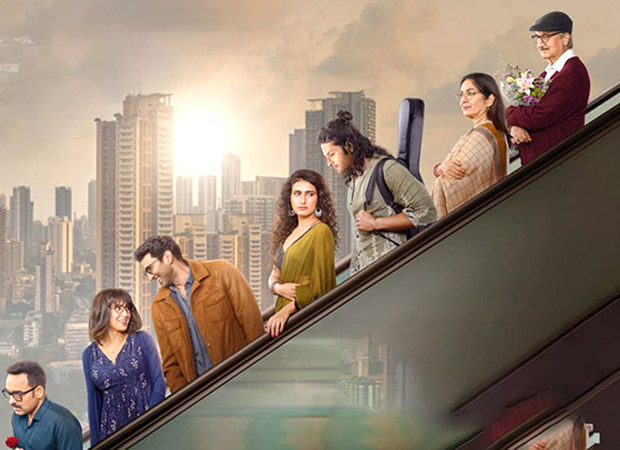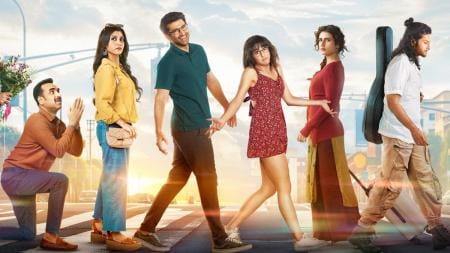If film reviews were meant to be as absolute as court judgments, Metro…In Dino would occasion a split jury. For every charge that it is pronounced guilty, it can just as easily be declared innocent. For one, the film cannot stake a claim at calling itself a new-age feminist narrative, not if the Bechdel test is one’s method of choice. But do the confused and unabating desires of all its female protagonists become the driving force of the narrative? That’s a resounding yes. Similarly, Metro…In Dino strays far and wide from the prescribed three-act structure of a quintessential screenplay, but it is precisely this messy, meandering storytelling that makes the film so compelling in the first place. And most importantly, does the film match up to what is being touted as its ‘spiritual predecessor,’ Anurag Basu’s own 2007 cult classic Life in a…Metro? Many have used their soapbox to cry dissent. But does Metro…In Dino becomes, in this era of nostalgia-fueled filmmaking, a larger lesson on how to do a homage right? Fantastically.
Love aajkal, desi style!
This is merely a summary of the questions most critics seem to be grappling with in their reviews of Metro…In Dino. Fortunately for us, however, we must not take on the heavy burden of a jury with a consensus. After all, someone, somewhere, a long time ago, already decreed for us quite conveniently that all is fair in love and war. Released after a five-year-long hiatus, Anurag Basu marks his own directorial return to the silver screen, with a return, not just to the rain-drenched and kaali-peeli-ed streets of Y2k Bombay, but with a return to the genre of the love story itself. Released at a juncture when most of Bollywood seems to have slipped down a rabbit hole of action sequences and whodunit narratives, Metro…In Dino wages a loud war against the accusation that the contemporary Hindi film industry has forgotten its roots in the classical trope of the rom-com musical. Taking it a notch higher, Basu seems to have embraced both the idiosyncrasies of his ways, as well as a legacy that is gone, but has not been forgotten.

Weaved out of six, maybe seven interconnecting storylines, Metro…In Dino poses the age-old question of finding love in the midst of urban loneliness, and inflates it to more contemporary proportions. Think, a whole season of Modern Love condensed into a two-and-a-half hour runtime, Basu’s newest seems to have it all: an aging housewife who rediscovers an old passion courtesy of an old beau, a cheating husband and an ingenious wife who conjures far more interesting plots of revenge than the generic old murder sequence, a young girl in her mid-twenties who, like most of the GenZ audience, is forever sick of a surfeit of choice (pun intended) and a teenager in love with both her best friend and her best friend’s crush. Metro…In Dino, just like its eighteen-year-old precursor, is a foray into all things love and all its messy, sticky, honeyed affairs.
Echoes of Life in a…Metro
On the face of it, the connections between Life in a…Metro and Metro…In Dino are splintered far and wide. We see a few familiar faces reprised in different roles, with Konkana Sen Sharma as the primary example. The character named “Monty,” played by the late Irrfan Khan in the first one, makes a return bearing Pankaj Tripathi’s slapstick humor, albeit with none of the old-school charm. “Shruti” recurs as the name of the character played by Fatima Sana Sheik, and a major subplot in the first one is echoed by the topsy-turvy romance between Sara Ali Khan and Aditya Roy Kapur. A specifically indelible scene from the original, in which Irrfan Khan drags Konkana Sen Sharma to one of the many high-rise rooftops that dot the skyline of Mumbai to prompt her to scream all her anger into the humid city air, is recreated just short of fidelity, this time in Delhi’s Agrasen ki Baoli. As it were, Mumbai is no longer a central character in this reprise. True to its word, Metro…In Dino sprawls itself over the many high-functioning cities of India, including Pune, Bangalore, and even Kolkata.
Metro…In Dino is not just a parable of Gen Z love lives, but rather an allegory for the contemporary film industry at large. Just as online dating apps and filtered profiles have hinged the idea of desire onto patterns of algorithmic predictability and ultimately, boredom, the film industry has increasingly turned toward content that sells rather than stories that stay recalcitrant despite, and perhaps because of, how frequently they are repeated as tropes.
Despite the list of differences and similarities, however, the two films resonate with each other by finding a synchronicity in the very pulse of their narratives. Condensed into a crisp monologue that prompts a combined set of “aha!” moments for our ensemble, the meaning of the first parable was declared to the audience by Dharmendra, as he sat mourning the death of the only recently reunited love of his life: “In my search for something new, something better, I lost sight of what was right in front of me. One must listen to what the heart desires, before it is too late.” The dialogue prompts the denouement of Life in a…Metro, concluding as Bollywood films from the 2000s were wont to do, in a trifold railway chase sequence.
Taking direct inspiration from its predecessors’ ending, Metro…In Dino pushes Neena Gupta’s character into the spotlight, and bids her to make a similar move, this time with a contemporary twist. “Most of us never know what we want,” she says, “and overwhelmed by choice, we reconcile with the safer, more secure option. But deep down, usually, the heart knows what it really wants.” The sermon is not lost on any of us. With most of us nurtured as children of the internet, the idea that more choices offer more comfort has been increasingly revealed as an illusion. Too many options, each an inevitable variation of the other, only puts us where Sara Ali Khan’s character oscillates during the entirety of the film, in a state of constant, but volatile, confusion. Thus spoilt for choice, we choose the comfortable option, the one we think guarantees future happiness. In trying to prolong this state of supposed satisfaction, we often forget that comfort is merely another word for predictability.
Metro…In Dino and bollywood landscape
In many ways, then, Metro…In Dino is not just a parable of Gen Z love lives, but rather an allegory for the contemporary film industry at large. Just as online dating apps and filtered profiles have hinged the idea of desire onto patterns of algorithmic predictability and ultimately, boredom, the film industry has increasingly turned toward content that sells rather than stories that stay recalcitrant despite, and perhaps because of, how frequently they are repeated as tropes.

An auteur at worst and a veteran at best, Anurag Basu is no newcomer to the rules of this game. Since its very inception, Bollywood has been defined by its consistent usage of tropes and symbols that percolate from generation to generation. The chiffon sarees in exotic hills, the quintessential love triangle, and even the never-ending parade of musical love numbers have all come to define Bollywood as a genre, but they have been slowly and surely disappearing in lieu of a more commercial, hyper-globalized form of cinema that increasingly irons out its own particularities in favor of mass international appeal. Today, we live in a different era of the industry, where films are routinely criticized for the lack of a ‘realistic’ portrayal of their subject, or the faulty ‘logic’ of their screenplay. By and by, we have forgotten the fantasmatic appeal of the silver screen, and precisely why Bombay came to be known as the sapnon ka sheher: the Hindi film industry had always been about the production of dreams. An obsession with realism and watertight scripts has only ever been a consequence of Hollywood’s hegemony over global forms of cinema.
Metro…In Dino poses the age-old question of finding love in the midst of urban loneliness, and inflates it to more contemporary proportions.
Anurag Basu’s Metro…In Dino does not just revive his own older production, but rather the days of Bollywood, where a script was more than just the structure of its story. Even with its messy and overstuffed screenplay, Metro…In Dino succeeds at what one can call a highly ambitious attempt at resurrection. This is not to say that the film reverts to the era of the retro, however. If the “In Dino” or the “nowadays” of its title is meant to be taken seriously, the film uses the form of nostalgia to give shape to the very contemporarity of its love stories, and if such a subject matter calls for a mess of plotlines, then so be it. This is not Basu’s first rodeo. Ensemble writing of this sort has been associated with him for a long time, as in Ludo (2020) and more obviously, Life in a…Metro itself.
Mixing in the form of the Hollywood musical together with the more classical Bollywood song-and-dance variety has also been attempted before, with Ranbir Kapoor and Katrina Kaif in the wacky slapstick Jagga Jasoos (2017). With this in mind, the breakage of the act structure, the messiness of the converging stories, and above all, the nostalgic return to the era of the rom-com, seem like deliberate choices that veer far from playing it safe.
Performances and pitfalls
There are several pitfalls to this, of course, some more obvious than others. Fatima Sana Shiek, for example, is less than optimal in her performance, and seems to hold back the seasoned Ali Fazal from delivering his usually strong performance as well. Between this unremarkable pair, their subplot, which already reels from a certain redundancy, seems more and more of an afterthought. While Aditya Roy Kapur is quite the charmer, eye candy like this always bears the risk of running a plot a little too sweet, which is where the insipid Sara Ali Khan almost becomes a welcome reprieve. Almost. But if there are potholes to navigate, there is also the promise of a bountiful downpour. Konkana Sen Sharma is stupendous as always, and Pankaj Tripathi serves his usual mix of pathetic charm.
Despite the mishaps, despite seeming like it plays its hand at nostalgia marketing, what charms us all about Metro…In Dino is the sheer amount of risk it is willing to take, all in a bid to tell a heartfelt story. Playing a cheating husband for laughs is no longer a predictable move for an increasingly moralistic audience, and neither is rehashing the trope of the womanizer turned faithful for the one girl who seems to want nothing to do with him. To bring back Pritam after the days of his long-sustained internet hate is a testament to Metro…In Dino’s resolute fidelity. The film even manages to touch upon the teenage struggle of sexual identity, through a fifteen-year-old who has more kiss scenes than any of her adult counterparts.
Metro…In Dino is brave, and it works. One comes to root for the characters despite the messy crisscross of subplots and the overstuffed details. Perhaps because in its longer-than-usual runtime, you grow to become attached to so many different characters. Perhaps because of the sheer overabundance of choice, there’s someone in there for everyone. Or perhaps because, somehow, somewhere, we all seem to know that love is a lot like this hot mess, too.
About the author(s)
Ananya is a writer and researcher of all things literature. With a particular emphasis on film, gender, and sexuality, she is great at curating the perfect movie night, but when it comes to life itself, she's still figuring out the script.






Very Interesting to read , keep it up Aananya.
beautifully articulated. really enjoyed reading .
keep it up.